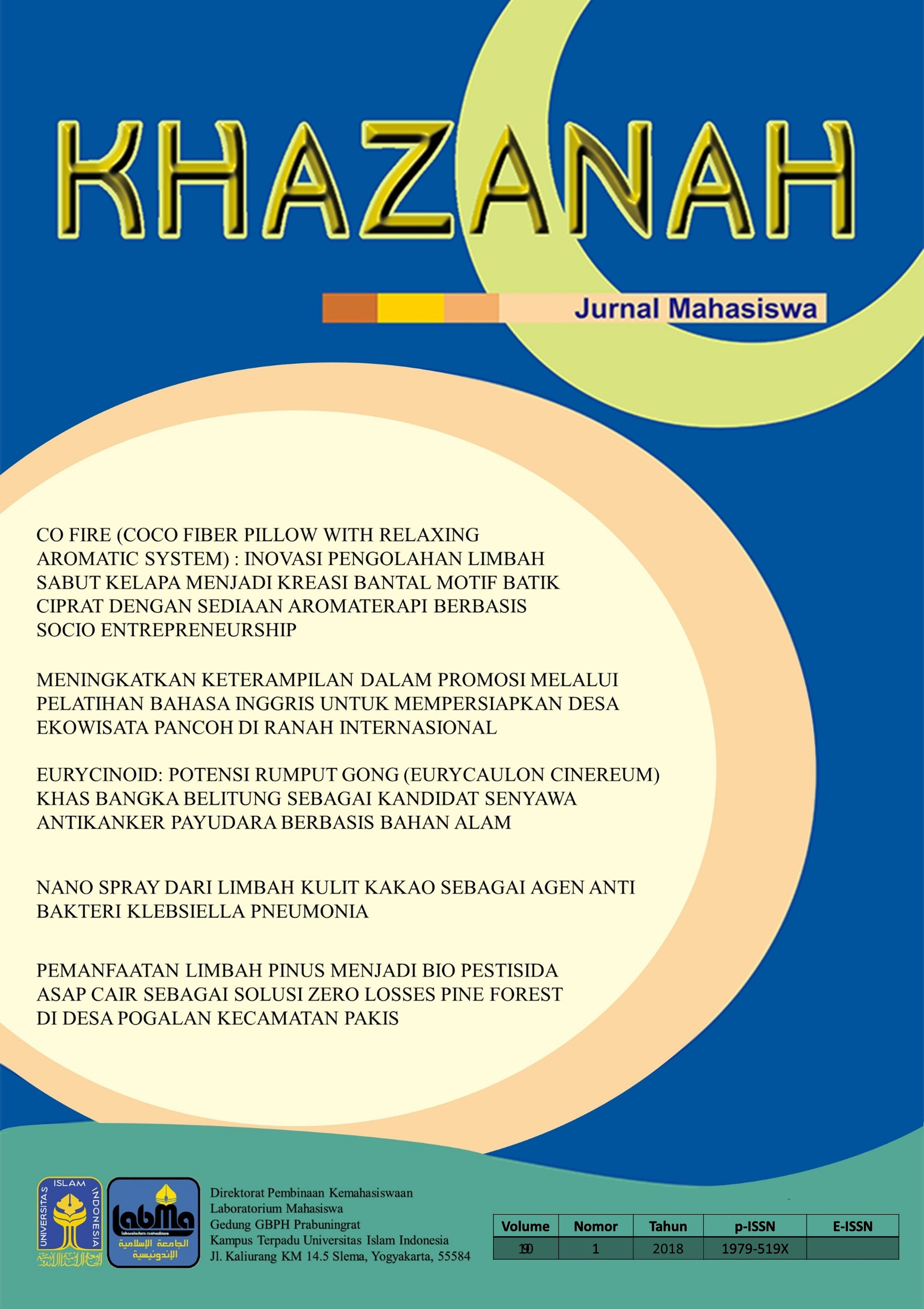Main Article Content
Abstract
Indonesia merupakan negara ketiga dengan jumlah perokok terbesar (Afiati,2016). Asap rokok mengandung senyawa racun organo klorin yang dapat memicu pertumbuhan bakteri Klebsiella pneumoniae yaitu salah satu bakteri penyebab bronkitis kronik (Ikawati,2011). Saat ini pengobatan untuk bronkitis kronik telah dilakukan dengan antibiotik, akan tetapi memiliki kekurangan yaitu alergi, iodosinkranasi dan dapat menyebabkan resistensi bakteri. Disisi lain, kulit kakao merupakan limbah utama dari pengolahan biji kakao untuk berbagai produk coklat. Diketahui bahwa terdapat senyawa flavonoid dari kulit buah kakao (Hu dan Li, 2011). Flavonoid merupakan senyawa yang diduga mampu menghambat pertumbuhan bakteri Klebsiella pneumoniae penyebab penyakit bronkitis (Kandou, 2016). Pada penelitian ini kami memanfaatkan limbah kulit kakao sebagai solusi pengobatan bronkitis kronik dengan menggunakan metode nanospray yang berbasis gelasi ionik. Prinsip nano digunakan untuk memperkecil ukuran zat aktif sediaan obat sehingga lebih mudah diabsorpsi kedalam sel target. Metode isolasi flavonoid yang digunakan adalah maserasi serbuk kulit kakao dengan etanol 96% perbandingan 1:10 selama 24 jam. Isolat kemudian di saring dan pelarut pada filtrat diuapkan dengan rotary evaporator sehingga diperoleh ekstrak kental kulit kakao yang mengandung flavonoid. Pembuatan nanospray isolat kulit kakao yang mengandung flavonoid menggunakan metode gelasi ionik dengan bahan NaTPP 0,1% b/v dan beberapa variasi konsentrasi kitosan yaitu 0,1%; 0,3%; 0,4% (b/v). Sediaan koloid yang diperoleh dengan ukuran paling kecil adalah menggunakan konsentrasi kitosan 0,1% dengan ukuran partikel 470,7 nm. Diharapkan dengan adanya pembuatan nanospray inhaler dari limbah kulit kakao ini menjadi langkah inovatif yang memberikan tiga keuntungan sekaligus yaitu (i) nilainya yang ekonomis (ii) sebagai solusi alternatif pengobatan penyakit bronkitis kronik yang tepat sasaran dan (iii) mampu mengatasi permasalahan lingkungan akibat limbah kulit kakao
Article Details
License
1. Proposed Policy for Journals That Offer Open Access
Authors who publish with this journal agree to the following terms:- Authors retain copyright and grant the journal right of first publication with the work simultaneously licensed under a Creative Commons Attribution License that allows others to share the work with an acknowledgement of the work's authorship and initial publication in this journal.
- Authors are able to enter into separate, additional contractual arrangements for the non-exclusive distribution of the journal's published version of the work (e.g., post it to an institutional repository or publish it in a book), with an acknowledgement of its initial publication in this journal.
- Authors are permitted and encouraged to post their work online (e.g., in institutional repositories or on their website) prior to and during the submission process, as it can lead to productive exchanges, as well as earlier and greater citation of published work (See The Effect of Open Access).
2. Proposed Policy for Journals That Offer Delayed Open Access
Authors who publish with this journal agree to the following terms:- Authors retain copyright and grant the journal right of first publication, with the work [SPECIFY PERIOD OF TIME] after publication simultaneously licensed under a Creative Commons Attribution License that allows others to share the work with an acknowledgement of the work's authorship and initial publication in this journal.
- Authors are able to enter into separate, additional contractual arrangements for the non-exclusive distribution of the journal's published version of the work (e.g., post it to an institutional repository or publish it in a book), with an acknowledgement of its initial publication in this journal.
- Authors are permitted and encouraged to post their work online (e.g., in institutional repositories or on their website) prior to and during the submission process, as it can lead to productive exchanges, as well as earlier and greater citation of published work (See The Effect of Open Access).
How to Cite
Lestari, R., Wicaksana, A. S. A., Puspitasari, K., & Syukri, Y. (2020). NANO SPRAY DARI LIMBAH KULIT KAKAO SEBAGAI AGEN ANTI BAKTERI KLEBSIELLA PNEUMONIA. Khazanah: Jurnal Mahasiswa, 10(1). Retrieved from https://journal.uii.ac.id/khazanah/article/view/16676
